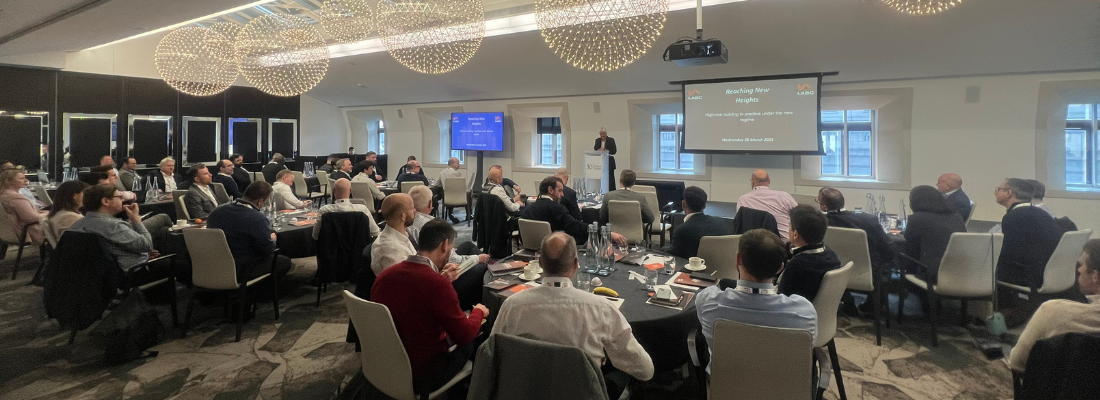Building safety conference hits the heights
The ‘Reaching New Heights Conference’, hosted by LABC and LABC Warranty, explored how the construction sector has been reshaped following the Grenfell tragedy.
Aimed at contractors, designers and consultants, the event offered practical tips and insights for those designing and building high-risk projects under the new legislative regime.
In her opening address, Lorna Stimpson, CEO at LABC, welcomed the government response to the Inquiry, and its plans to act on all 58 recommendations.
She also outlined the changes that LABC and building control have gone through post-Grenfell. This includes the move to a registered profession and significant investment in learning and development materials to support the new competence regime.
The success of the LABC Academy was also mentioned, which has brought 150 new trainee building control surveyors into public service building control.
Keynote from MHCLG
Chandru Dissanayeke, director at the Ministry of Housing, Communities and Local Government (MHCLG), provided the keynote. He said that the Grenfell fire “uncovered profound issues in our built environment.”
He challenged the industry to invest in more capacity and capability so that it can successfully respond to the changes brought about by the Building Safety Act.
“Issues at Gateway 1 have been resolved,” Chandru said. “But both the sector and the regulator need to improve at Gateway 2. The statutory 12-week timescale was designed to be a stopgap, not a target, and the objective was to be much faster.
“But the quality of the applications also has to improve. The industry and the regulator need to work together.”
Gateway 2 – getting the documentation right
Two of the speakers provided their perspectives on the Gateway 2 process.
Allan Binns, director at Project Four Safety Solutions, focused on the importance of getting the compliance statement right.
“Every design decision needs to be justified against each of the relevant regulations and pieces of guidance,” he explained. “You should be thinking about how to make it as clear as possible for the regulator. Make sure that documents are consistently named, organised in a logical way and clearly signposted.”
This approach was backed by Iain Liversage, group technical director at Hill Group. He said that making decisions earlier in the design process also helped. Hill Group is working up to RIBA Stage 4B before submitting to the regulator. He explained that this was improving the approvals process for them.
Fire expertise shared
Ian Leigh, policy officer for the Building Safety Programme Team at National Fire Chiefs Council (NFCC), offered a firefighter’s perspective on the second staircase legislation. He also explained how fire crews work in high-rise blocks and how designers could help them to be more effective by designing buildings with them in mind.
Other speakers included Charles-Elie Romeyer, head of technical policy at the Building Safety Regulator. He described the changes to Approved Document B. He added that the Document is under constant review, with testing and research ongoing to ensure that guidance is fit for purpose.
Adrian Dobson, executive director of knowledge and standards at RIBA, shared insights into the Institute’s work on competence. This included a guide on designing safety critical elements, developed in partnership with the CIOB, and the importance of getting procurement right. This included a suggestion to appoint the Principal Designer as early as possible.
Construction products were covered too. Paul Morrell OBE, who led the Independent Review of the Construction Product Testing Regime with Anneliese Day KC, said that the scale of the problem was huge. He shared his disappointment that manufacturers had not taken on any new responsibilities post-Building Safey Act.
His view was that standards “should not be seen as red tape” and that the industry needs to get better at what he called passing on the “relay of responsibility.” He said the onus should be on manufacturers to demonstrate that products are fit for purpose, properly tested and certified.
Help from LABC and LABC Warranty
The event was closed by LABC Warranty. Colin Lendon talked about the importance of early engagement from a warranty perspective, and described how the organisation works closely with LABC. Benefits include a reduction of risk, with qualified, competent people carrying out multiple inspections on site.
A mention was also given to LABC’s training offer for Tier 1 contractors. Launched earlier this year, it helps contractors to build and demonstrate competence within their technical teams.
Sign up to the building bulletin newsletter
Over 48,000 construction professionals have already signed up for the LABC Building Bulletin.
Join them and receive useful tips, practical technical information and industry news by email once every 6 weeks.
Subscribe to the Building Bulletin



